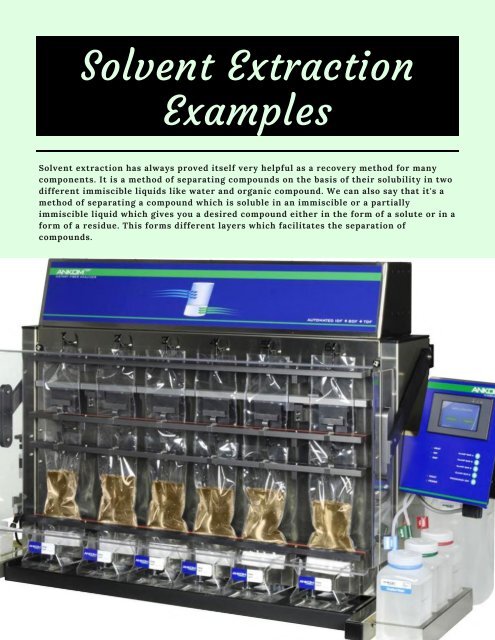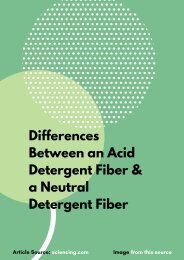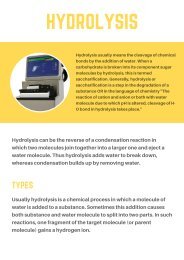Solvent Extraction Examples
Create successful ePaper yourself
Turn your PDF publications into a flip-book with our unique Google optimized e-Paper software.
<strong>Solvent</strong> <strong>Extraction</strong><br />
<strong>Examples</strong><br />
<strong>Solvent</strong> extraction has always proved itself very helpful as a recovery method for many<br />
components. It is a method of separating compounds on the basis of their solubility in two<br />
different immiscible liquids like water and organic compound. We can also say that it's a<br />
method of separating a compound which is soluble in an immiscible or a partially<br />
immiscible liquid which gives you a desired compound either in the form of a solute or in a<br />
form of a residue. This forms different layers which facilitates the separation of<br />
compounds.
EXAMPLES<br />
The simplest solvent extraction<br />
examples may be derived from<br />
water and organic compounds.<br />
For example: Benzene is non<br />
polar and is immiscible in water<br />
as the polarity of water is very<br />
high. So, if we want to separate<br />
benzene from a liquid which<br />
contains a component that<br />
dissolves in water, then we can<br />
mix it with water and the<br />
separated layer will be benzene.<br />
<strong>Solvent</strong> extraction is also widely used in the petrochemical refining<br />
industries. Extracted petroleum has lots of impurities and therefore it<br />
cannot be used for any purposes. Hence, this extraction is used to purify the<br />
product. Special solvent is introduced in the petroleum which reacts with<br />
the impurities and either settles them down or keep them floating. Then the<br />
impurities can be easily separated and pure petroleum is further packed for<br />
sale.<br />
SELECTION<br />
The solvent should be able to dissolve at least one component to a large<br />
extent than the rest of the components in the mixture.<br />
The reaction taking place should be stable and irreversible. Reversible<br />
reactions can bring back the dissolved components in their previous form<br />
and the extraction will not be completed successfully.<br />
The compound formed after the reaction should be easily separated from<br />
the extracted compound so that it can be reused.<br />
The density of the compound should be different from the required<br />
component to help the separation readily.<br />
It should be inexpensive and cost-effective.<br />
The solvent should not be toxic or corrosive as it can harm the extraction<br />
instruments.
CONDITIONS<br />
Condition under which the reaction or the extraction process takes place<br />
also affects the separation. Temperature and pH play a very important role<br />
in separating components. So it is very necessary to maintain the<br />
temperature and pH of the compound during the extraction process.<br />
Pressure does not affect the reaction much, as most of the solvent<br />
extractions are carried out under the atmospheric pressure. Other factors<br />
may be precipitation of solids, vapor pressure, etc. Apart from these factors,<br />
residence time is also important in the reactions like metals separation or<br />
short life components like antibiotics.<br />
Article Source:<br />
https://sciencestruck.com/solvent-extraction<br />
Image Source:<br />
Click this link






